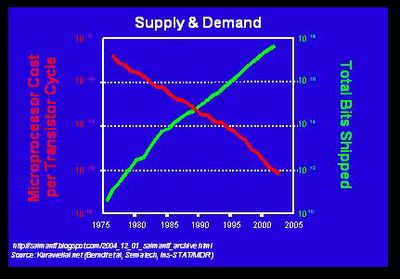Declining Price of Software / Web 2.0
Somewhat inspired by all the Web 2.0 Conference discussions, here is my take on Web 2.0:
- The price of creating new web based applications is plummeting, largely due to the Open Source Software and the Open Source movement's cultural influence.
- Think of what it takes to build some pretty sophisticated functionality using 'free' open source infrastructure (like LAMP or RoR), and support it with minimal resources. Compare this to the money you would have to spend to buy and support a Solaris/Oracle platform prevalent in the late nineties for example, and the point is made.
- What's more, the culture of sharing freely (which I think has been enhanced by the success of open source) allows for more and more new offerings which are free... while the companies creating them figure out their revenue models, which in turn, do not need to be outrageously high to cover their low costs!( I liked this related post on ning.)
- This creates a virtuous cycle of low cost tools enabling low cost apps, some of which are low cost tools...
- Plummeting costs of supplies inevitably result in experimentation and innovation
- This is not the first time this has happened. I go back to the chart I had used before, which continues to amaze me. (Credit goes to Kurzweil for thinking of a way to quantify this, and Larry Augustin who first got me thinking about it in this way.) It's pretty simple grade school economics - lower the cost and demand goes up! And this is on a logarithmic scale.
- The form this innovation is taking is that you get a lot of small groups (2-10 people say) that are creating very interesting software with minimal overhead. They sustain low burn - sometimes, these are people who became somewhat independently wealthy during web 1.0, and themselves may have low overhead lifestyles, and thus have a longer time frame before they need to monetize their creation. The idea is that they can sustain the burn and get ad-sense revenue or something while the site becomes more popular and then sell it for a few million to one of the internet giants
- The low cost infrastructure also means that web 2.0 businesses can go after smaller segments of the market to become real businesses (and potentially expand from there) - thus the long tail.
- It is a great environment for creative destruction. And before the destruction comes, you have a growing and immense supply of low cost applications being built on the web.
- I think the cost issue is a critical piece of web 2.0 (as I see it.) Clearly there are some other pretty important common themes.
- Broadband: Certianly, the web is 2.0 because it is relying on the infrastructure (actual mbps) and user base (network effects) that came on with web 1.0.
- Openness: ... as in open source, or APIs. It's all about linking content, code in innovative ways.
- Participation: I think a critical central theme to web 2.0 is the concept of participation by users, whether it is to contribute to the infrastructure (bit torrent), to the marketing (skype) or in the O'Reillian architecture of participation (with tagging, sharing, amazon reviews etc.)
- Revenue model: So all this is somewhat enabled by the micro revenue models specifically enabled by google ad-sense and Amazon affiliate programs... I recently talked to abusiness school student who created a site before bus school, and the site is "self sustaining" while he does his bus school and gets another job. Now how cool is that???


0 Comments:
Post a Comment
<< Home